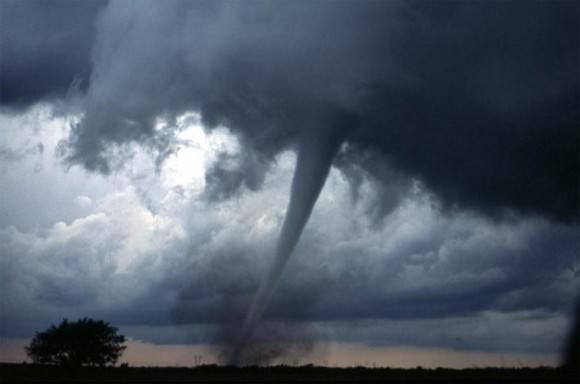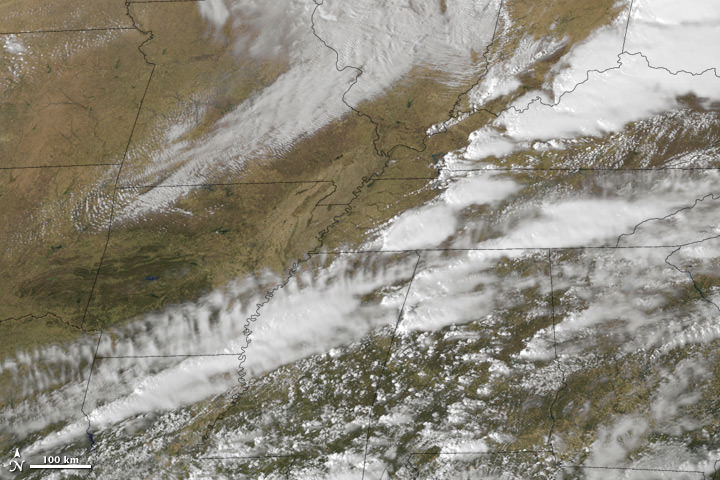[/caption]
The 2012 tornado season got off to a rousing start. Between February 28th and March 3rd, two deadly storm systems developed in the southern United States. The storms spawned numerous tornadoes that together killed at least 52 people. This kind of extreme tornado activity, so early in the year, has fueled fears that global warming will increase the severity and duration of the tornado season. But, scientific studies show that this is not necessarily to be expected.
Early tornadoes are not unheard of. For example, on February 29 in 1952, two tornadoes caused severe damage in the south-eastern US. But this year, the number of early tornadoes has been much higher. The National Oceanic and Atmospheric Administration reported that in January of 2012, the tornado total was 95, much higher than the 1991–2010 average of 35. And the five-day total for February 28 to March 3 could rank as the highest ever since record-keeping began in 1950, according to meteorologist Dr. Jeff Masters, co-founder of the Weather Underground. With such a record-breaking start, it is not surprising people worry that a more severe 2012 storm season is ahead, and that global warming is to blame.
Tornadoes form when warm and moist air from the Gulf of Mexico meets with very cold and dry air above, which was brought south from the arctic. The collision of these air masses, which have different densities, as well as speeds and directions of motion, forces them to want to switch places very rapidly. This creates updrafts of warm and wet air, which produce thunderstorms. And, as the updrafts climb through the atmosphere, they encounter fast- moving jet stream winds, which change speed and direction with altitude. These changes give the updraft a strong twisting motion that spawns tornadoes.
The severity of tornadoes is rated on the Fujita Scale, which examines how much damage is left after a tornado has passed: F0-F1 tornadoes produce minor damage and so are considered weak, F2-F3 tornadoes produce significant damage and are considered strong, and F4-F5 tornadoes produce severe damage and are considered violent. The problem with this ranking is that it is related to a human-based assessment of damage; you need something (buildings, vegetation, etc.) to be destroyed and someone to see the damage. So, a severe tornado that occurs somewhere where there is nothing to be destroyed would be classed as weak, and one that occurs where there is no-one to see the damage wouldn’t even be counted.

Still, tornado awareness and volunteer reporting programs, along with good record-keeping, have significantly improved our understanding of tornadoes and their frequency. Surprisingly, the Storm Prediction Center’s tornado database, which goes back to 1950, does not show an increasing trend in recent tornadoes. This finding is confirmed by Dr. Stanley Changnon from the University of Illinois at Urbana-Champaign, whose study of insurance industry records was published last year. Dr. Changnon’s work shows that tornado catastrophes and their losses peaked in the years between 1966 and 1973, but have shown no upward trend since that time. In fact, the number of the most damaging storms, those rated as F2 to F5 has actually decreased over the past 5 decades. So, it does not appear that global warming is increasing the number of tornadoes that occur.
This is actually not as surprising as it seems. While a local increase in temperature and humidity, whether caused by global warming or not, would be expected to create more thunderstorms, it is not clear that these thunderstorms would spawn tornadoes. The reason is that global warming does not increase temperatures the same everywhere. Warming at the poles is expected to exceed warming at more southern latitudes. This means that cold polar air will be much less colder than before and warm Gulf of Mexico air will only be slightly warmer. When these two air masses meet above the southern US, the temperature difference between them will not be so great and their drive to swap places will be much less intense. The result will be a significantly slower moving updraft of warm air that is not expected to produce as many extreme thunderstorms or spawn as many tornadoes.
So, global warming is not expected to increase the total frequency of tornado activity. However, warming global temperatures will mean an earlier spring and the potential for earlier tornadoes. In fact, the early tornado numbers we’ve seen so far this year may be a sign of a global warming-induced shift in the tornado season, according to Dr. Masters. If this is the case, the tornado season may start earlier, but it will also end earlier. As meteorologist Harold Brooks from the National Severe Storms Laboratory in Norman, Oklahoma, points out, this record start to the 2012 tornado season does not necessarily mean the rest of the season will be severe.
Sources:
Recap of deadly U.S. tornado outbreak February 28-March 3, 2012, M. Daniel, EarthSky Mar 5, 2012.
NASA Earth Observatory, March 5, 2012.
Temporal distribution of weather catastrophes in the USA, S.A. Changnon, Climatic Change 106 (2), 129-140, 2011, doi: 10.1007/s10584-010-9927-1.
Does Global Warming Influence Tornado Activity? Diffenbaugh et al., EOS 89 (53), 553-554, 2008.


“So, global warming is not expected to increase the total frequency of tornado activity. ”
In science I expect you to show this (negative) statement, either through experimental statistics or formal mathematical proof.
Well, dude, that’s why Irene provided the sources at the bottom of the article.
The only source that references Climate Change is the last one, and it’s from 2008.
That’s not really how science works… there is no burden to prove something doesn’t exist (in this case, a correlation), and that is especially true when there is a sound theory as to why that something isn’t expected to exist.
This article about Russell’s teapot does a good job of exploring that particular philosophical aspect of science.
As I recall the movie “An Inconvenient Truth” brought up the very active 2004 tornado season as an example of how climate change is affecting the Earth.
For his work, Gore received an Oscar, an honorary doctorate, and the Nobel Peace Prize.
He didn’t receive those awards just because of that one example in his film.
Remember, Yassar Arafat (the terrorist) was awarded a Nobel PEACE prize. Don’t put too much stock in those politically motivated bozos in Scandinavia.
The Award does not represent true or false, right or wrong. It is awarded for saying what the committee likes to hear.
Soo…. It is not unusually early, and there is no increase in numbers of tornados, and the last couple of years were not early seasons, and this early start does not necessarily mean a longer season, or that the rest of the season will be severe, but this is all due to climate change. All what?
Where did you get that from? The entire viewpoint of this article is that global warming is not expected to increase the total frequency of tornado activity (paragraph 7).
The title of the article makes that clear too – the fears are unfounded.
“Tornadoes form when warm and moist air from the Gulf of Mexico meets with very cold and dry air above, which was brought south from the arctic. The collision of these air masses, which have different densities, as well as speeds and directions of motion, forces them to want to switch places very rapidly. This creates updrafts of warm and wet air, which produce thunderstorms. And, as the updrafts climb through the atmosphere, they encounter fast- moving jet stream winds, which change speed and direction with altitude. These changes give the updraft a strong twisting motion that spawns tornadoes.”
I hate to nitpick, but this explanation has a few problems. One of the biggest myths about tornado formation is that they are created from the collision of cold and warm air masses. This is simply not the case. It’s true that part of what fuels tornado formation is very warm and moist air in the low-levels, that underlies cooler and drier air above, but there is no collision going on here. The warm and moist air “slides” freely below the cooler and drier air above. What happens in such a situation is that the low-level air becomes very unstable to vertical displacements, such that a parcel of air that begins to rise (due to any number of factors, such as local heating, or wind convergence a dryline or frontal boundary) will continue to accelerate upward, possibly developing into a thunderstorm updraft. Condensational heating in the updraft further warms the air and causes it to accelerate upward. Meteorologists call this potential energy source “CAPE”, which stands for Convective Available Potential Energy. Tornadoes tend to form in environments with fairly high CAPE, but not always.
Second, it’s true that the changing wind speed with height is responsible for updraft rotation (rotating thunderstorms are called supercells), but it doesn’t have to involve a jet stream (though it sometimes does). In fact, there is a lot of evidence that the wind profile *below* the jet stream level is most important for supercells, with the winds at jet stream level playing a somewhat lesser role. Wind profiles that are most favorable for tornadic supercells are usually those that *veer* in direction with height (that is, the wind vector rotates clockwise with height; e.g., from the SE at the surface, S at 1 km, SW at 3 km, and WSW at 6 km), and also increase significantly in speed.
Finally I have a quibble with your explanation about why global warming may not increase tornado risk. It’s actually quite likely that in a warming climate, thunderstorm updrafts *themselves* will actually be as strong or even stronger on average than they are now. However, what might really put a damper on increased tornadic activity is an overall reduction in vertical wind shear, not CAPE. In other words, the weakening temperature gradient between equator and poles expected in a warming climate would lead to weaker mid-to-upper level winds (these winds are driven by a balance between the N-S pressure gradient and the Coriolis force; the N-S pressure gradient would be weakened along with the weaker N-S temperature gradient). These weaker winds aloft mean less wind shear (less increase in wind speed with height), which means weaker updraft rotation overall in supercells, and therefore less of a tornado risk.
The biggest question of research in this area right now is the relative importance of these two effects. If CAPE increases more than the wind shear decreases, it could compensate for the weaker shear, and just as many tornadoes or more may result. If it’s the other way around, we might expect less tornadoes. The jury is still out.
Forgive me for the long-winded and critical response, but as a tornado researcher, I just wanted to clear the air a bit.
One other thing: the source of cool and dry air aloft can often be traced back to the higher terrain of the mountain west or desert southwest, which blows over the top of the warm and moist air from the Gulf of Mexico. Arctic air masses are actually rarely involved in tornado environments.
No need to apologize — thanks for taking the time to put together such a clear and detailed explanation, it was very interesting.
Hmmm… sounds almost like republican logic here? MY scientist is better than YOUR scientist! Denial being key…
A contributing factor might include the coming solar maximum? It’s effects on the polar jet stream seem relevant.
Think about the record heat and cold waves we’ve been experiencing- whirled wide. Global warming? You ain’t seen nothing yet kids…. Think about the billions of tons of methane currently (Pun intended ~@; ) being released from the melting permafrost.
Eeyup… when our coastal cities are inundated by sea water, someone’s scientist will claim that it must be caused by all the Wren’s pissing gleefully into the sea~